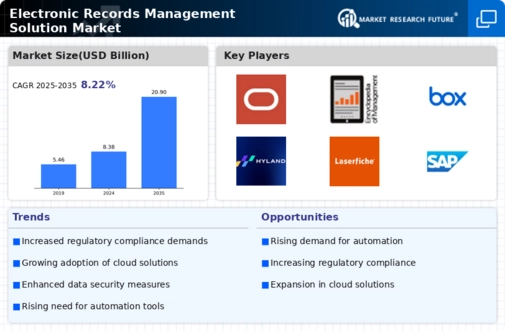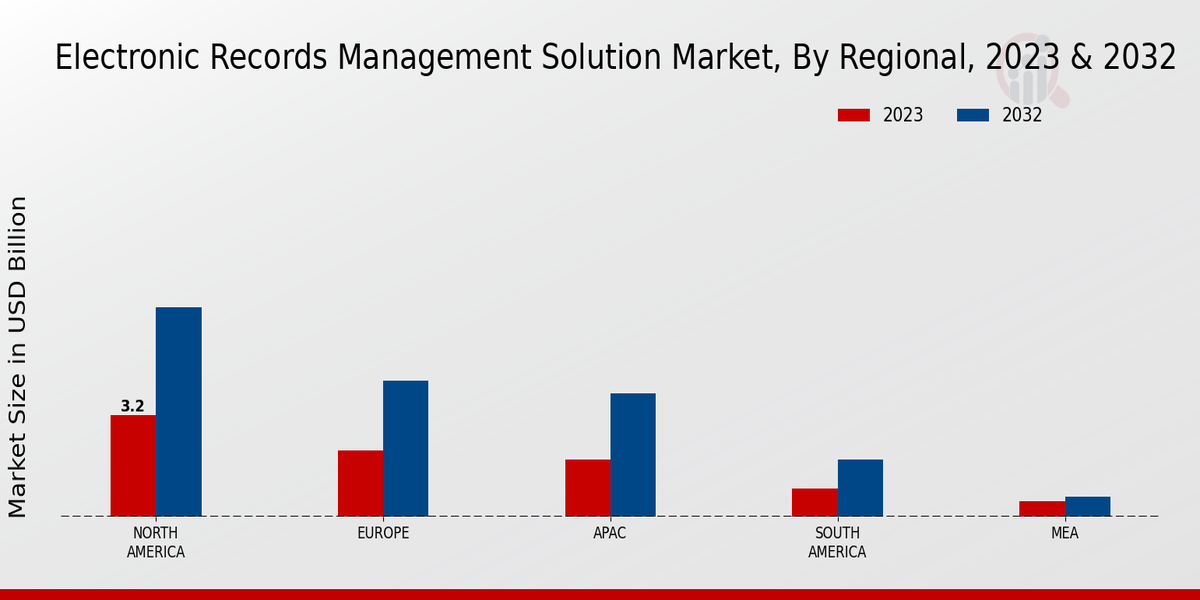Market Growth Projections
The Global Electronic Records Management Solution Market Industry is projected to experience substantial growth in the coming years. With a market size expected to reach 8.38 USD Billion in 2024 and further expand to 20.9 USD Billion by 2035, the industry is poised for significant development. The compound annual growth rate of 8.67% from 2025 to 2035 indicates a robust demand for electronic records management solutions. This growth is driven by various factors, including regulatory compliance, data security, and technological advancements, which collectively contribute to the industry's positive outlook.
Enhanced Focus on Data Security
The Global Electronic Records Management Solution Market Industry is driven by an enhanced focus on data security and protection against cyber threats. Organizations are increasingly aware of the risks associated with data breaches and are investing in electronic records management solutions that prioritize security features. This trend is particularly pronounced in sectors such as finance and healthcare, where sensitive information is at stake. As a result, companies are seeking solutions that offer encryption, access controls, and audit trails to safeguard their records. This heightened emphasis on security is likely to propel market growth as organizations strive to protect their data assets.
Rising Data Volume and Complexity
The Global Electronic Records Management Solution Market Industry is significantly influenced by the rising volume and complexity of data generated by organizations. As businesses increasingly rely on digital platforms, the amount of data they produce continues to grow exponentially. This surge necessitates advanced electronic records management solutions capable of efficiently organizing, storing, and retrieving vast amounts of information. Companies are recognizing the need for sophisticated systems that can handle this complexity, leading to a projected compound annual growth rate of 8.67% from 2025 to 2035. This growth reflects the urgency for effective data management strategies in an evolving digital landscape.
Growing Adoption of Cloud-Based Solutions
The Global Electronic Records Management Solution Market Industry is witnessing a surge in the adoption of cloud-based solutions, which offer flexibility, scalability, and cost-effectiveness. Organizations are increasingly migrating their records management systems to the cloud, enabling remote access and collaboration. This shift is particularly evident in small and medium-sized enterprises that seek to reduce infrastructure costs while enhancing operational efficiency. The cloud-based segment is anticipated to contribute significantly to the market's growth trajectory, with projections indicating a market size of 20.9 USD Billion by 2035, driven by the ongoing digital transformation across industries.
Increasing Regulatory Compliance Requirements
The Global Electronic Records Management Solution Market Industry is experiencing heightened demand due to increasing regulatory compliance requirements across various sectors. Organizations are compelled to adhere to stringent regulations regarding data management, privacy, and security. For instance, industries such as healthcare and finance face rigorous standards that necessitate robust electronic records management systems. This trend is expected to drive the market's growth, as companies seek solutions that ensure compliance while minimizing risks. As a result, the market is projected to reach 8.38 USD Billion in 2024, reflecting the urgency for effective records management solutions.
Integration of Artificial Intelligence and Automation
The Global Electronic Records Management Solution Market Industry is evolving with the integration of artificial intelligence and automation technologies. These advancements enable organizations to streamline their records management processes, enhancing efficiency and accuracy. AI-driven solutions can automate routine tasks such as data entry and classification, reducing the burden on personnel and minimizing human error. This technological integration is expected to attract organizations seeking to optimize their operations and improve productivity. As the market continues to innovate, the adoption of AI and automation is likely to play a pivotal role in shaping the future of electronic records management.















